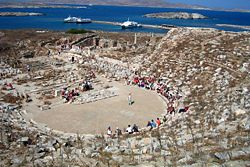Archaeological Museum of Delos

Delos Theatre. The World Heritage site surrounding the museum which supplied the museum with its collection.
|
|
| Established | 1904 |
|---|---|
| Location | Delos, Cyclades, South Aegean, Greece |
| Type | Archaeological museum |
The Archaeological Museum of Delos (Greek: Αρχαιολογικό Μουσείο Δήλου) is a museum on the island of Delos, near Mykonos in the South Aegean, Greece. It is noted for its extensive collection of statues unearthed in the surrounding area of the ancient site, which has been declared a UNESCO World Heritage Site. Although the museum has a considerable collection, it does not contain all of the items found in Delos: a large quantity are on display in Athens at the National Archaeological Museum.
In 1872, the French School at Athens began excavating on Delos, in a project on a massive scale, which is still ongoing today.
As the collection accumulated, the museum was built on-site in 1904 by the Archaeological Society of Athens to accommodate the archaeological discoveries. Its original five rooms went underwent expansion in 1931 and then again in 1972 to nine rooms.
The museum's notable collection of funerary statues and grave stelae ranging from the 7th to the 1st century BC form the bulk of the collection. Its ancient pottery collection dates from the 25th to the 1st century BC, while the clay figurines, jewellery and mosaics conserved in the museum date back to the 2nd-1st centuries BC. Six rooms contain the statues and reliefs found in Delos;,two rooms contain the pottery and another room contains items used in everyday life in ancient Greece.
Of major note is an ivory plaque which dates to 1400-1200 BC that depicts a Mycenaean soldier clad with a helmet made from wild boar teeth with defensive shield and spear. It was discovered at Artemision along with other gold, ivory and bronze items. The museum has a 5th-century marble statue of Boreas which portrays the infamous kidnapping of the Athenian princess Oreitheia and marble statues of Dioskourides and his wife Kleopatra, who lived on Delos island. The statues, which were unearthed at their former residence, date from 138 BC, according to the inscription on the base, which indicates they were erected by Cleopatra in order to honour her husband, who dedicated two silver tripods to the temple of Apollo.
...
Wikipedia
